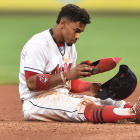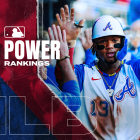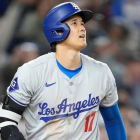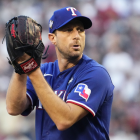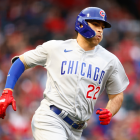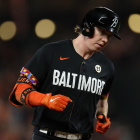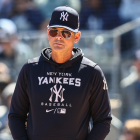It's hard to marshal much in the way optimism, hope, after what's befallen the Indians the last two postseasons. In the 2016 World Series, they frittered away a three-games-to-one lead over the Cubs and as a capstone endured an agonizingly white-knuckled loss in Game 7. This year, they won 102 games in the regular season and, unlikely 12 months prior, boasted a healthy rotation. In keeping with expectations, the Tribe barged to a 2-0 lead over the Yankees in the best-of-five ALDS. Joe Girardi's grave managerial gaffe in Game 2 gave a veneer of certainty to the whole thing.
But because baseball is at time cruelly beholden to the unexpected, the Indians -- strangely freighted down its best players -- squandered the series lead and saw a season end with neither belt nor title for the 69th straight time. "Maybe next year" for squadrons like the Indians is tiresome beyond the usual cliched nature of such a lamentation, but look around: It's all they've got right now.
So next year, maybe. The Twins are coming off a trip to the postseason (albeit one that lasted not even nine innings), so they're to be taken seriously. The White Sox have an uncommonly bright long-term future, but being "not objectionably bad" rather than "good" is their near-term outlook. The embers from the Tigers' teardown are still smoking -- you can smell them and everything -- and the below-.500 Royals are poised to be waylaid by free agent losses. All of this is to say: The AL Central, home to the Indians, figures to be eminently winnable by those very same Indians.
Cleveland is indeed well-positioned, at least for 2018. Corey Kluber, Francisco Lindor, Jose Ramirez, Andrew Miller, Carlos Carrasco, and Edwin Encarnacion are all under team control through at least next season. Framed another way, Carlos Santana, Jay Bruce, and Bryan Shaw are the most significant pending free agents on the roster. You can't hand-wave away those three talents, but they're replaceable in the event they go elsewhere.
Speaking of the implied topic of free agents, the Indians this past season ran an Opening Day payroll of roughly $140 million. At present, they'll head into the 2017-18 offseason with just a bit more than $75 million in guaranteed salary commitments. The Indians have a number of notable contributors in line for arbitration raises, so that's going to bump the payroll up. Even after that, though, there will be some flexibility. The front office knows it's in win-now mode, and last year's surprise $60 million signing of Encarnacion shows a willingness on the part of the Dolan family to invest in the product.
If the Indians opt to keep Jason Kipnis in the outfield, then Bruce's forthcoming departure may not be such a concern. Young Bradley Zimmer will return from his hand injury and likely pin down center. While Michael Brantley's health will always be a concern, the Indians have an option on him for 2018 that they may exercise. Lonnie Chisenhall is quite effective as the primary half of a corner platoon.
Or maybe they prefer to move Kipnis back to second base, thus shoring up the infield. If that's the case, then perhaps the Indians would do well to target, say, Lorenzo Cain on the market. Cain had an impressive season in 2017 and boasts a lengthy track record of strong performances. As well, Cain's on the wrong side of 30, which could tamp down his going rates and make him a good fit for a win-now mid-market club team like Cleveland. Even with Zimmer's high ceiling, the Indians -- if Kipnis returns to the keystone, Bruce walks, and they cut bait on Brantley -- will likely need external help in the outfield. How they address that potential need may be the most interesting Indians subplot of the winter.
As for first base, Santana's a highly popular figure in Cleveland, with good cause. He has, however, shown some signs of decline. Perhaps the Indians will decide they need a bridge until Bobby Bradley's ready. While Eric Hosmer may not fit within the budget, Logan Morrison and Yonder Alonso will be free agents, too.
On possible in-house upgrade is at catcher. Yan Gomes and Roberto Perez have their catch-and-throw merits, but largely because of those two the Indians got production from their backstops that was somewhat below the league standard for the position. It certainly didn't sink them, but it's an opportunity for upgrade. That upgrade could come in the person of Francisco Mejia. The 21-year-old Mejia got an 11-game cameo with the big-league clubs this season, and he figures to be ready for regular duty at some point in 2018. The switch-hitter famously logged a 50-game hit streak in the Midwest League in 2016, and he continued producing at a high level in Double-A this year. He'll soon provide the Tribe with offensive ceiling that haven't enjoyed at the catcher position in a long time. Mejia is one of the top prospects in all of baseball, and he could help the Indians in 2018.
Speaking of 2018, it would be inaccurate to call it the Indians' last best chance, especially with young stars and potential stars like Francisco Lindor, Jose Ramirez, Zimmer, and Mejia in the fold. They'd do well to lock up Andrew Miller beyond next season, and they'll need to hope that Encarnacion doesn't hit deep decline before then. Also, the White Sox will very likely be ready to matter by 2019, and the Twins figure to be of note. The further out you get, the less certain things become.
So for the Indians, it looks promising for 2018 -- you know, next year. You've heard this before, but they'll again be good enough to hoist the trophy for the first time since way back yonder in 1948. The cold reality is that the best way to win a World Series is to make the playoffs as often as possible and hope your number comes up. Since dice have no blood, the outer margins of probability on occasion afflict a team for, say, 108 or 69 years. It's just how it goes in this, our baseball.
The hope within and around the Indians is that, this time next year, some other team will be the most conspicuous victim of the vagaries of October. They've had their turn, you know.













